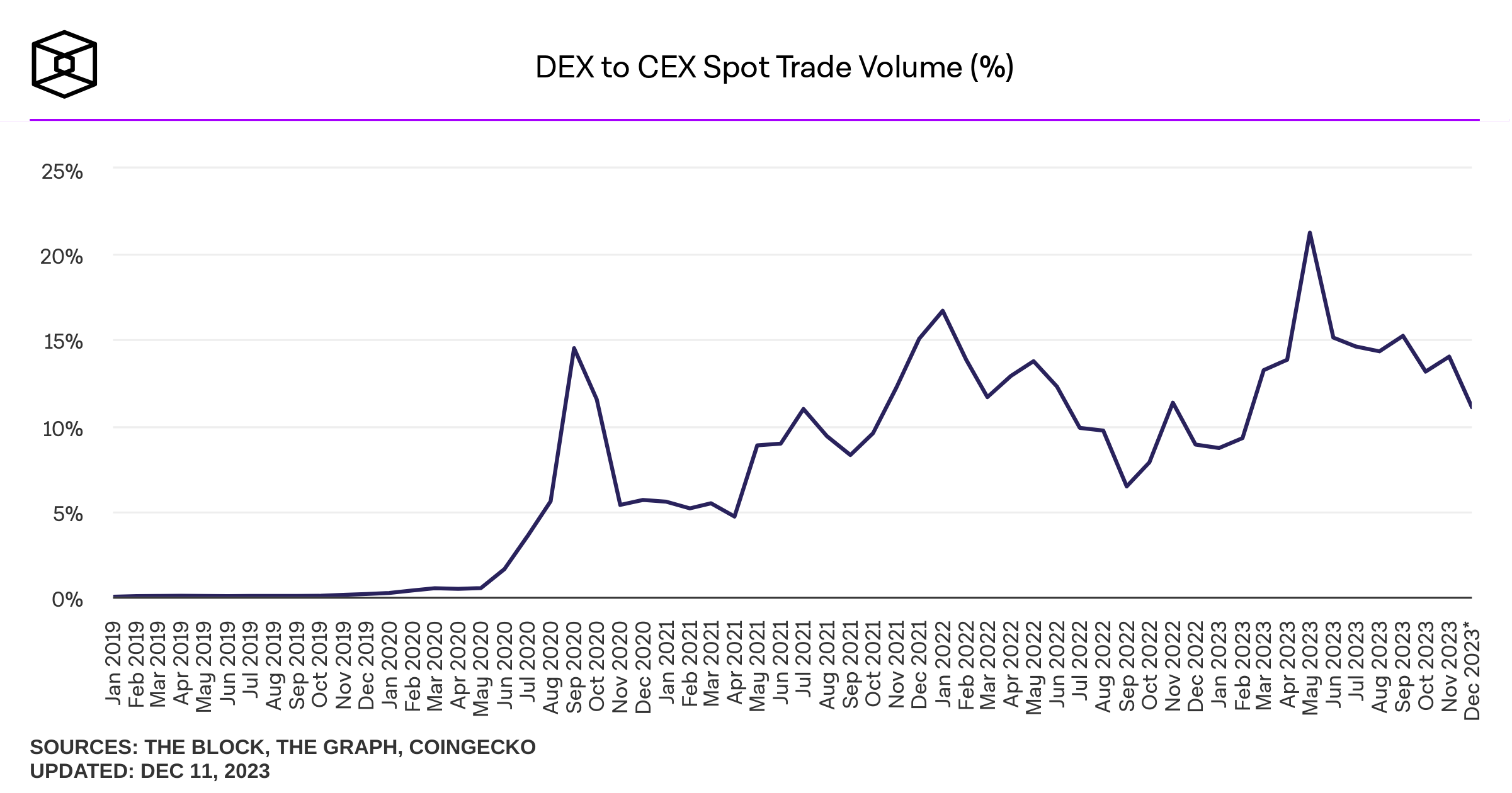CEX vs DEX: What are the differences between crypto exchanges?
Centralized and decentralized exchanges are platforms for trading cryptocurrencies. This article explores their differences in depth.
By Mrig P

Perhaps the most basic way to engage in Web3 is to buy or exchange crypto tokens.
To do this, a user must go to a crypto exchange, which comes in one of two forms: a centralized exchange (CEX) or a decentralized exchange (DEX).
Although both CEXs and DEXs allow users to exchange cryptocurrencies, they differ largely in how they work. Anyone looking to trade crypto must know these differences.
In this article, we review the major differences between CEXs and DEXs so you can make an informed decision about where to make your next crypto trade.
What is a Centralized Exchange (CEX)?
Centralized exchanges (CEXs) are cryptocurrency exchanges that monitor and facilitate crypto asset trading between users with the help of a centralized intermediary. Like traditional electronic stock exchanges, CEXs use an order book system to display and match buy and sell orders from users.

CEXs also often act as crypto on-ramps and off-ramps as many allow users to fund their accounts with fiat currency or liquidate their crypto assets back to fiat.
How do CEXs work?
To start trading on centralized exchanges, you may need to first get KYC verified, which requires you to upload information such as a photo of your government ID, address proof, and signature.
You can then deposit your fiat money or cryptocurrency to start purchasing or trading crypto assets listed on the exchange.
When you place a buy order on a CEX to buy a crypto token, the CEX order matching engine searches for a sell order that’s placed at the same price as your buying price. Once there’s a match, the CEX executes your trade and funds your account with the token you wanted.
Examples of notable CEXs include Binance, Kraken, Coinbase, and Gemini.
What is a decentralized exchange (DEX)?
Decentralized exchanges are crypto exchanges where users can swap one crypto token for another in a decentralized and non-custodial manner without centralized intermediaries. DEXs are also permissionless, meaning anyone can use a DEX without revealing their private information.

All you need to log into a DEX is a non-custodial crypto wallet.
How do DEXs work?
Instead of relying on a central company to operate, decentralized exchanges use self-executing, autonomous smart contracts to process token swap requests.
Initially, DEXs used on-chain order books, but this required every node of a blockchain to record a trade order before the order could get completed. As one might guess, this made the process unbearably slow.
The solution: automated market maker (AMM) decentralized exchanges. They use pre-funded pools of crypto assets called liquidity pools that usually hold token pairs in a 50/50 ratio.
Today, the most popular DEXs like Uniswap, Pancakeswap, Curve, and many others are all AMM protocols.
In the absence of an order book to assess supply and demand to update assets’ prices, AMMs use a mathematical formula.
The most commonly used formula is x*y = k, where x and y are the token balances and k is a constant. That means the constant balance of assets determines the price of tokens in the liquidity pool.
To learn more about how DEXs work, read our article What is a decentralized exchange (DEX)?
Centralized exchanges pros and cons
Pros of CEXs
High liquidity
Owing to their UI resemblance with Web2 platforms and their integration with traditional finance, a vast majority of crypto users prefer to trade on CEXs vs DEXs. This brings larger trade volume and higher liquidity to CEXs.
Simple fiat-to-crypto transactions
CEXs act as on-ramps and off-ramps, meaning users can easily convert fiat into crypto and vice versa.
Fast transactions
CEXs can process transactions more quickly than their decentralized counterparts as they use off-chain matching systems designed to handle a large volume of transactions.
More user-friendly
The user interface on a CEX is similar to traditional stock trading platforms, so they can be easier to navigate. Further, the exchange handles the transaction on the user’s behalf, which usually makes the process less complicated, especially for beginners.
More trading features
With centralized exchanges, users may also get more options for trading and investment, like spot trading, options, futures, leverages, etc.
Cons of CEXs
No privacy
Users must complete a mandatory identity verification process such as KYC to use a CEX. This requires users to share private information, which some may consider to be a barrier to entry.
Lack of control
In the case of CEXs, you do not own your private keys–the platform does. CEXs can suspend trading activities and prevent you from accessing your funds.
Loss due to hacks
CEXs maintain wallets controlled by a centralized organization to store users’ funds. In the event of a wallet hack, you may lose your funds despite having enabled all security measures.
Decentralize exchanges pros and cons
Pros of DEXs
Self-custody
With DEXs, your funds always remain in your non-custodial wallet. DEXs cannot freeze your funds or pause transactions.
Reduced security risk
A hack on a DEX doesn’t expose users’ funds. That means the overall risk in the event of a hack is lower when using a DEX.
No account restrictions
Since DEXs don’t require users to complete a KYC process, anyone can start trading cryptocurrencies in a matter of seconds.
Access to rare tokens
Since DEXs are permissionless, new projects can easily list their tokens and create liquidity pools. This offers users the chance to get in early on projects before they get listed on a CEX.
Cons of DEXs
Limited trading options
DEXs are mostly limited to conducting basic token swaps as they don’t have the necessary mechanism to analyze assets and implement different indicators, which may be important in some crypto trading.
Slower transaction speed
Given that a DEX conducts transactions on-chain, miners must validate these transactions before adding them to the block. This makes them slower than CEXs like Binance, whose matching engine is capable of sustaining more than 1,400,000 orders per second.
Lower trading volumes and liquidity
Although DEXs are growing in popularity, one can’t deny that CEXs still dominate them in terms of the trading volume.
According to data from Dune and The Block, CEXs have consistently handled the majority of spot trading volume. The largest percentage of spot trade volume performed via DEXs peaked at just above 21% in May 2023, with most of the volume hovering between 5% and 15% when compared to CEXs.

For example, back in 2021, CEXs saw over $14 trillion in trading volume while DEXs only topped $84.98 billion in the same period.
Less user-friendly
The user interface of DEXs can be hard to understand and navigate for beginners as they don’t resemble that of traditional stock trading platforms.
DEXs also require users to connect non-custodial wallets to execute trades and transfer funds, which might come off as a complex process.
Begin your crypto journey with MoonPay
Now that you know the difference between CEXs and DEXs, it’s time to test them out yourself.
To get started, simply buy cryptocurrency via MoonPay using your credit card or any other preferred payment method.
You can also kick off your crypto journey by topping up your wallet in euros, pounds, or dollars and use your MoonPay Balance for buying Bitcoin (BTC), Ethereum (ETH), and other tokens. Use your balance to enjoy lower transaction fees, quicker processing times, and better approval rates. Plus, withdraw to your bank account with zero fees when you're ready to cash out.
MoonPay also makes it easy to sell crypto when you decide it's time to cash out. Simply enter the amount of the token you'd like to sell and enter the details where you want to receive your funds.

.png)




